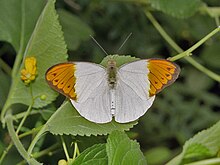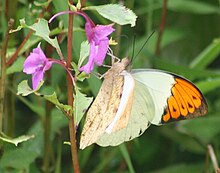Hebomoia glaucippe
| Great orange tip | |
|---|---|
 |
|
| Adult, dorsal view | |
 |
|
| Adult, showing underside | |
| Scientific classification | |
| Kingdom: | Animalia |
| Phylum: | Arthropoda |
| Class: | Insecta |
| Order: | Lepidoptera |
| Family: | Pieridae |
| Genus: | Hebomoia |
| Species: | H. glaucippe |
| Binomial name | |
|
Hebomoia glaucippe (Linnaeus, 1758) |
|
| Synonyms | |
|
|
Hebomoia glaucippe, the great orange tip, is a butterfly belonging to the Pieridae family, that is the yellows and whites. It is found in the Indomalaya ecozone and Wallacea.
This species is found in much of South and Southeast Asia, as well as in southern China and southern Japan.
Hebomoia glaucippe has the following 27 subspecies:
H. g. aturia male
H. g. formosana female
H. g. liukiuensis male
H. g. mindorensis male
H. g. sulphurea male
The following descriptions are true for much of its range. There are subspecies that differ, such as H. g. vossi where the white is replaced by pure yellow.
In the males the upperside is creamy white. Forewing: the costa narrowly, the apex and terminal margin to middle of interspace 1 are black. An irregular, somewhat sinuous, black band extends obliquely from beyond the middle of the costa across the upper apex of the cell, and meets at interspace 1 the black on the terminal margin. Within the triangle thus formed is enclosed a rich orange-red patch that is traversed by the black veins and bears in interspaces 3 to 6 a postdiscal series of black inwardly elongated spots. Hindwing: nearly uniform, touched with black on the terminal margin anteriorly and with a conspicuous postdiscal black spot in interspace 7. In some specimens there are one or two smaller spots in continuation of the series in the interspaces below.
The underside is white. The apical third of the forewing and the whole of the hindwing are mottled, with more or less prominent brown stripe and spots. Costa of the forewing and a fine line that runs from base of the hindwing through the cell, straight to the middle of the terminal margin, are brown. Antennae are dark brown. The head and thorax have anteriorly a reddish-brown pile. Thorax above is greyish blue, while the abdomen is white with a bluish tinge. Beneath: head and thorax are more or less brownish, abdomen is white.
Female is similar to the male. Upperside: ground colour with a slight greenish tinge. The orange patch on the forewing is more restricted, it consists of a series of brood streaks in interspaces 3 to 6 and 10, the outer apices of which are deeply incised by black and with a row of hastate orange spots beyond in interspaces 2 to 6. Hindwing: similar to the hindwing in the male, but with a postdiscal series of large triangular black spots and a terminal connected series of still larger triangular black spots at the apices of veins 2 to 7. Underside: similar to that in the male, the brown transverse strigae and spots are more numerous, the costa of the fore and the median line on the hindwing are very prominently brown. Antennae, head, thorax and abdomen as in the male.
...
Wikipedia
